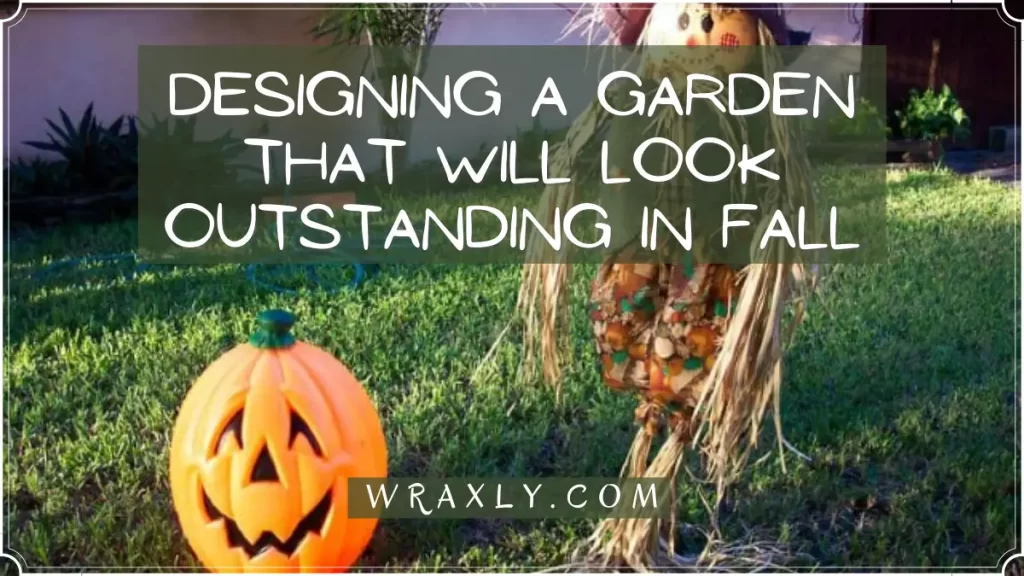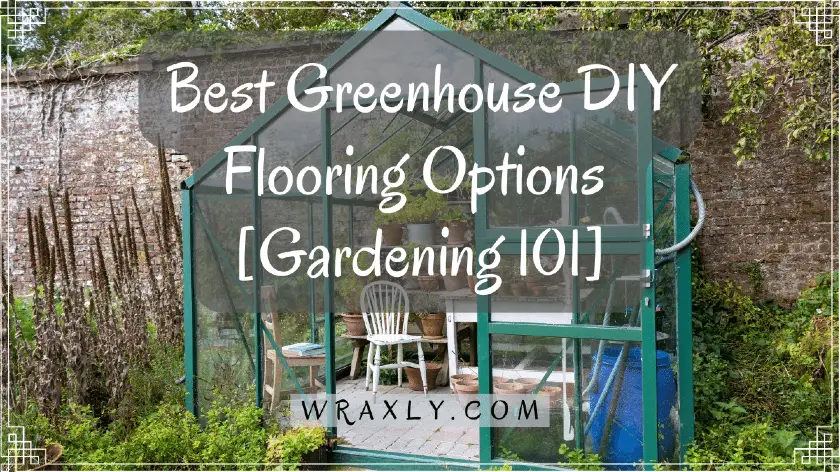Gardening is a popular pastime in the United Kingdom, with many people of all ages enjoying getting outdoors and tending to their gardens.
If you’re a gardening enthusiast, then you’ll be interested in this roundup of 169 latest gardening statistics in the UK that you need to know.
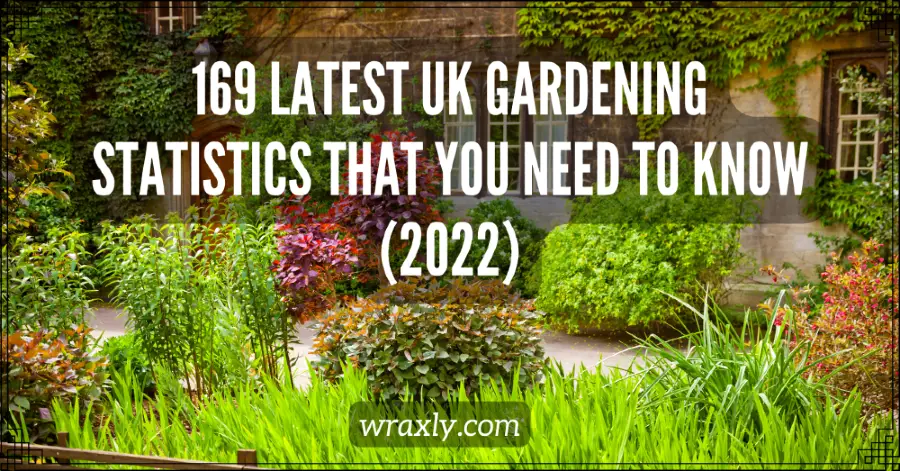
- Why Gardeners Garden
- How We Use Our Outdoor Spaces
- UK Gardening Lockdown Statistics
- Where Gardeners Garden
- Gardening Participation in the UK
- How Much Time Do Gardeners Spend in Their Gardens
- What Gardeners are Growing
- Where People Get Information About Gardening
- Where gardeners shop
- What Brits spend on their gardens
- Gardening Doesn't Always Come Up Smelling like Roses
- Gardening DIY (Not!)
- Blog Post Sharing Policy
Why Gardeners Garden
51%. The percentage of British adults that say they get a good deal of pleasure from their gardens. (hta.org.uk)
42%. The number of people noticing an improvement in their mood from gardening. (UK gardening trends are evolving)
35%. Number of gardeners that say it gives them a sense of wellbeing. (Garden Trends Report 2018)
43%. Number of gardeners that say it makes them feel calm. (Garden Trends Report 2018)
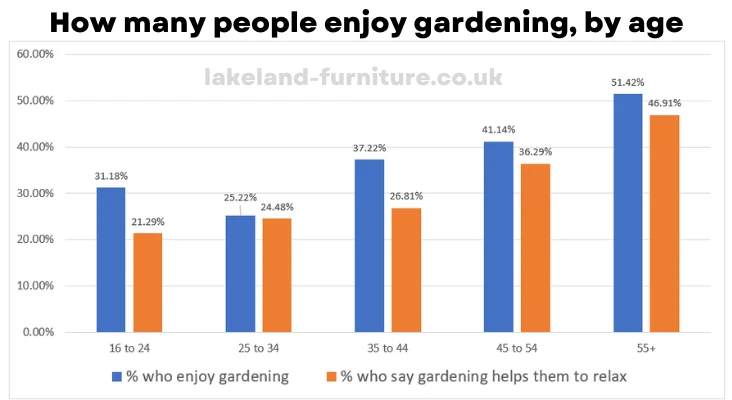
84%. Percentage of UK adults that say gardens and enjoying outdoor spaces benefits their physical health. (Garden Industry Statistics)
Two in five believe being surrounded by greenery impacts their mood while 45% use them as something to concentrate on. (independent.co.uk)
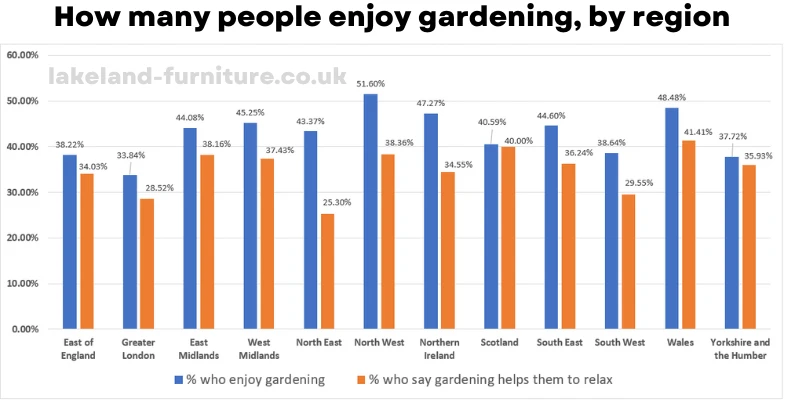
82%. The percentage of Brits that would like to attract more wildlife into their gardens. (Garden Trends Report 2018)
37%. Percentage of British gardeners that claim that having more wildlife is the most appealing garden feature. (Garden Trends Report 2018)
67%. Percentage of people that consider themselves to be eco-conscious when it comes to gardening. (Garden Trends Report 2018)
86%. Percentage of gardeners that try to feed or provide a home for the birds in their garden. (Garden Trends Report 2018)
52%. Percentage of UK adults that use their outdoor space to feed or watch wildlife. (Garden Industry Statistics)
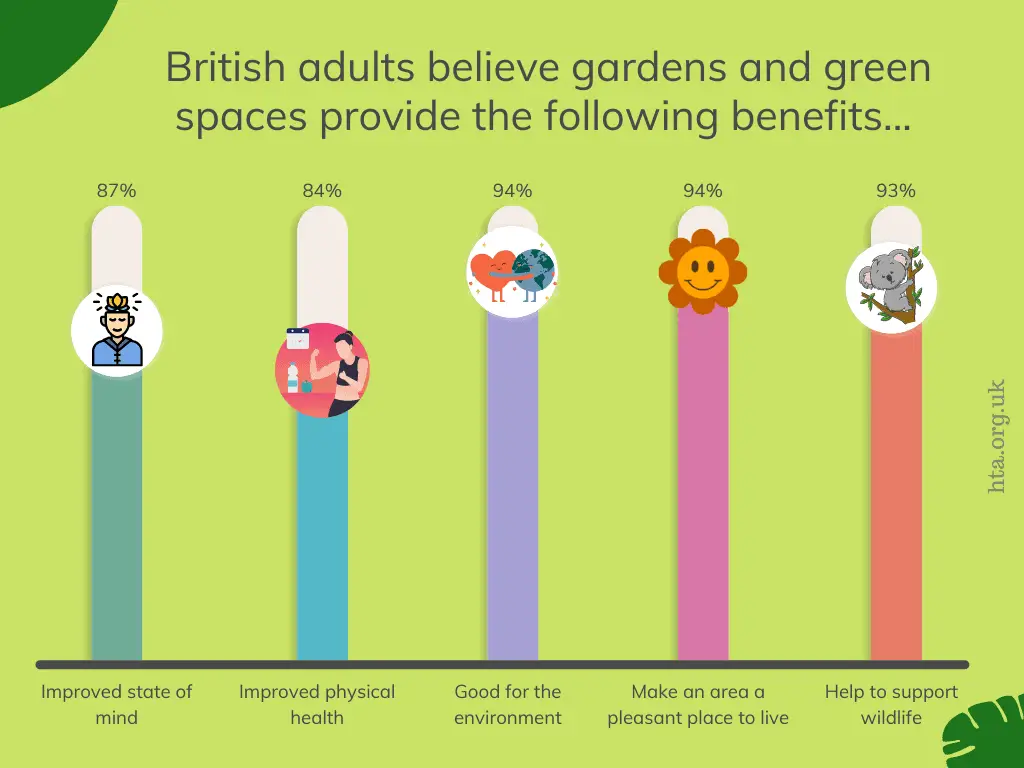
88%. Percentage of UK adults that say having access to a garden or public green spaces is important to them. (Garden Industry Statistics)
94%. Percentage of UK adults that say gardens and green spaces benefit the environment. (Garden Industry Statistics)
93%. Percentage of UK adults that say gardens and green spaces benefit wildlife. (Garden Industry Statistics)
How We Use Our Outdoor Spaces
43%. Percentage of those with outdoor spaces that use them for entertaining. (Garden Industry Statistics)
23%. Percentage of families with gardens that use them as a dedicated play area. (Garden Industry Statistics)
77%. Percentage of those with gardens that use them as a space to relax. (Garden Industry Statistics)
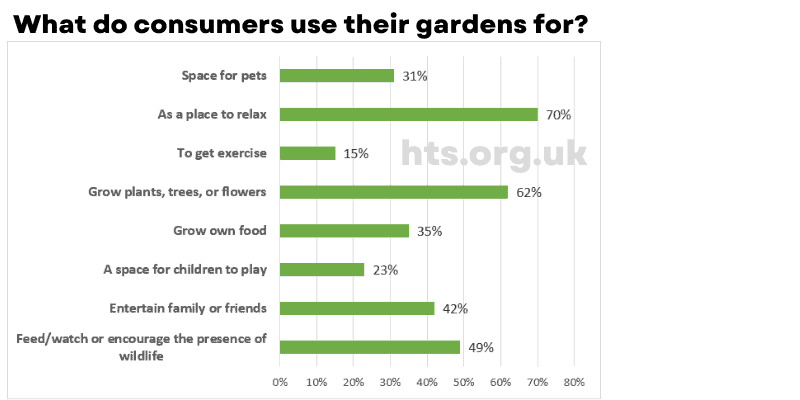
UK Gardening Lockdown Statistics
35%. Percentage of citizens in the United Kingdom who were surveyed stated that they purchased outdoor plants during the pandemic. (Stastic.com)
25%. Percentage of those who have worked from home during the pandemic that have bought houseplants for their work area. (independent.co.uk)
59%. Percentage of gardeners who visited their garden at least once a day during the lockdown. (University of Surrey)
1 in 10. Number of people who had no access to a garden or found it difficult to access one. (University of Surrey)
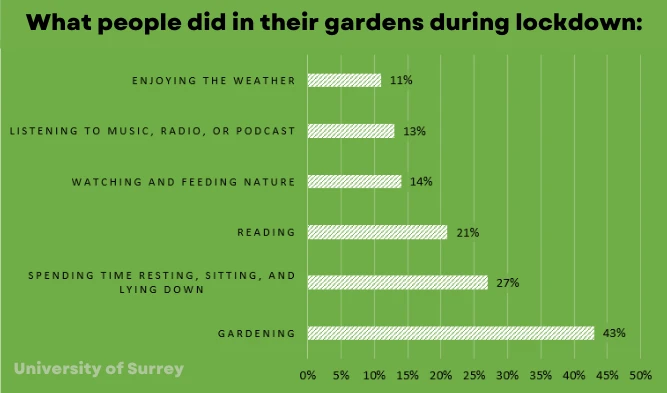
77% of people had increased their gardening habits due to the UK lockdown. (RattanDirect)
9% of people were gardening less. (RattanDirect)
93% of women were now gardening more, of which 20% of them were 18-24 year-olds. (RattanDirect)
18%. Percentage of British adults who believe they will do more gardening post-lockdown. (gardenforum.co.uk)
Gardening sales grew faster in the UK than in Europe during the lockdown. The biggest drivers for growth were indoor plant sales, seeds, pot plants and garden care. (gardenforum.co.uk)
Indoor plants have been boosted by, among other things, greater demand from those wanting to improve the look of their home office for Zoom calls. (gardenforum.co.uk)
Where Gardeners Garden
80%. Percentage of UK adults that have access to a garden or outdoor space. (Garden Industry Statistics)
Changes in home ownership will see over two million homes without gardens in 2018. (Garden Trends Report 2018)
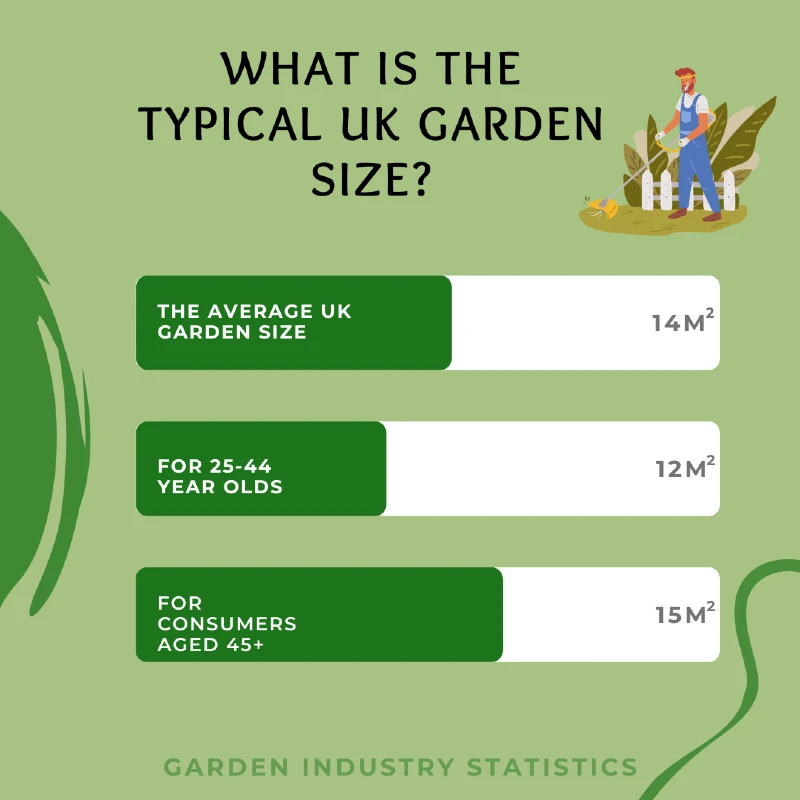
14m2 – the size of the average UK domestic garden. (Garden Industry Statistics)
12m2 – average size of a garden for the 25–44-year-olds. (Garden Industry Statistics)
15m2 – average size of a garden for those aged 45 years or over. (Garden Industry Statistics)
75%. The percentage of British adults that have access to a private garden. (hta.org.uk)
The combined area of the UK’s domestic garden is roughly the same as the whole of Somerset. (hta.org.uk)
Gardening Participation in the UK
Over two-thirds of British adults visit a garden centre every year. (hta.org.uk)
Almost half of adults our of 2000 surveyed admitted they have killed an average of five houseplants unintentionally. (independent.co.uk)
Poole, Dorset. UK city with the biggest average garden size. (Statista.com)
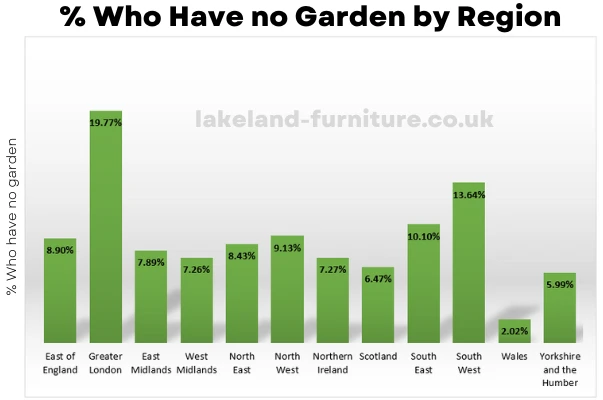
28%. Percentage of adults in the UK that stated that they had vegetable patches in their gardens in 2021. (Statista.com)
15%. Percent of respondents that stated that they had garden gnomes in their garden. (Statista.com)
20%. Percentage of adults surveyed that have sung to their shrubs. (independent.co.uk)
10. The average number of plants that 18–24-year-olds have in their home. (independent.co.uk)
29% – Increase in millennials enjoying gardening. (UK gardening trends are evolving)
30% – Percentage of people who feel they do not have the tools or skills to garden. (UK gardening trends are evolving)
69% of under-45s believe they have fewer gardening skills than their parents. (Garden Trends Report 2018)
3.5 million. Number of people who have taken up gardening in 2020. (UK gardening trends are evolving)
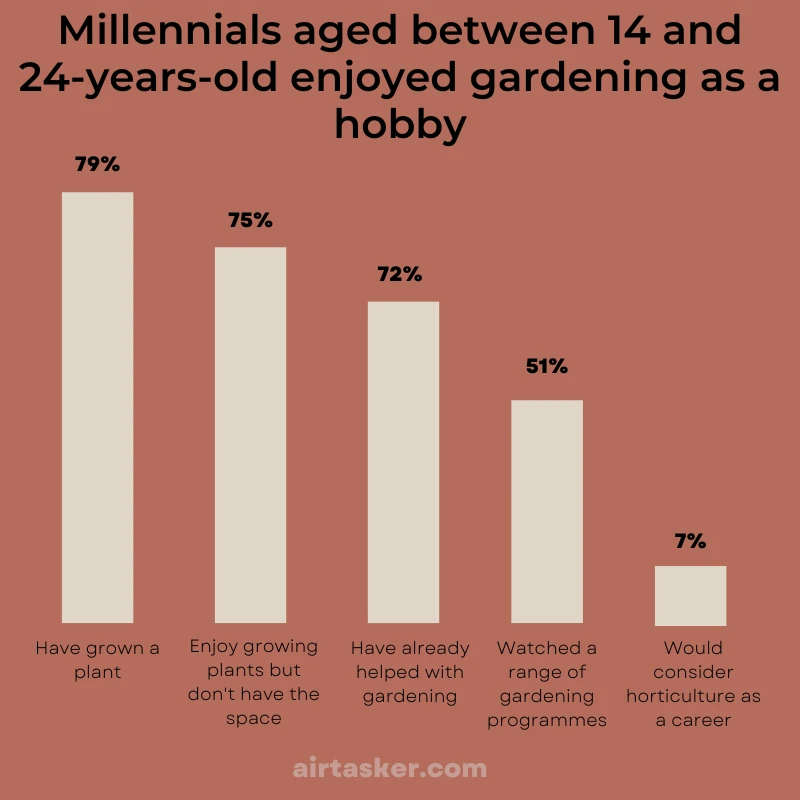
31%. Percentage of British gardeners admit to feeling guilty when their plants die. (Garden Trends Report 2018)
7%. The percentage of Brits who have been gardening for more than 30 years that consider themselves experts. (Garden Trends Report 2018)
90,000. The number of people on allotment waiting lists. (Garden Trends Report 2018)
69%. The number of people who grow plants in the kitchen. (Garden Trends Report 2018)
43% of gardeners under 40 grow their own vegetables compared to 32% of over 60s. (Garden Trends Report 2018)
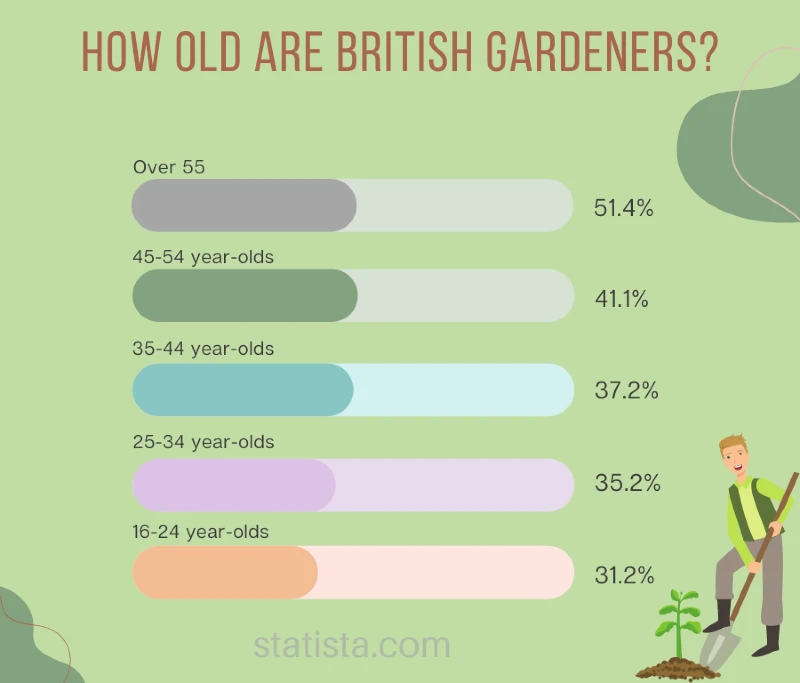
2%. Percentage of gardeners that feel that they have the knowledge to adapt to a changing climate. (Garden Trends Report 2018)
58%. The increase in applications for The Royal Horticultural Society’s (RHS) work-based programmes in 2021, the highest in decades. Of the applications received, 74% considered themselves to be career changers, with 25–34-year-olds accounting for 39% of applicants and 35-44-year-olds for 17%. 49% were women. (gardenforum.co.uk)
The value of home-produced vegetables increased by 10% to just under £1.7 billion in 2020, and the volume of home production increased by 3% to 2.6 million tonnes. (Horticulture Statistics 2020)
Home production of vegetables contributed to around 56% of the total UK supply in 2020, compared to 53% in 2019. (Horticulture Statistics 2020)
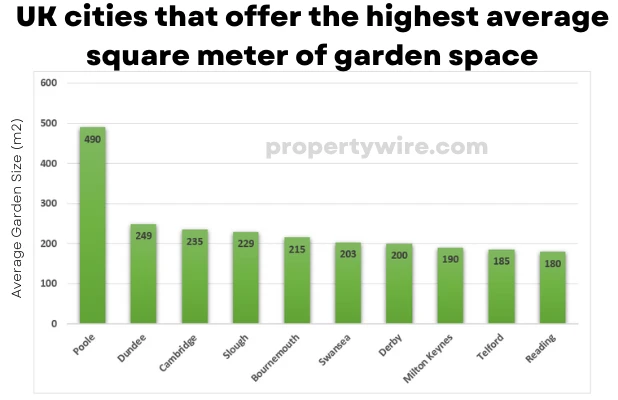
Home production contributed 16% of the total UK supply of fruit in 2020. (Horticulture Statistics 2020)
1.5 million – approximate number of children involved in some form of school gardening. (Garden Industry Statistics)
75% – of UK primary schools offer gardening as an extra-curricular activity. (Garden Industry Statistics)
34% – of UK primary schools offer gardening as part of the curriculum. (Garden Industry Statistics)
33p – average budget given to schools for gardening projects, per pupil. (Garden Industry Statistics)
1 in 8 (12%). The number of British households that don’t have access to a garden. (ons.gov.uk)
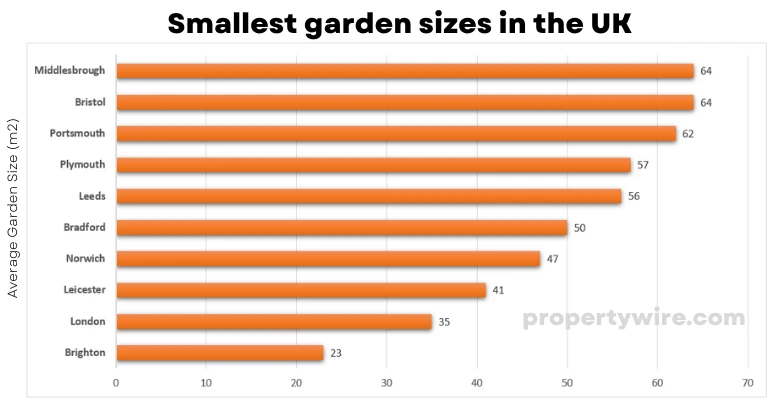
1 in 5 (21%). The number of London households that don’t have access to a garden. (ons.gov.uk)
8%. The percentage of people aged 65 years and over that don’t have access to a garden. (ons.gov.uk)
Gardens in London are 26% smaller than the national average and the smallest of any region or country in Great Britain. (ons.gov.uk)
28%. Percentage of people in Great Britain live within a five-minute walk of a public park or garden. 72% live fewer than 15 minutes away. (ons.gov.uk)
58%. Percentage of people living in London that live within a five-minute walk of a park or garden. (ons.gov.uk)
How Much Time Do Gardeners Spend in Their Gardens
16 minutes. Weekly amount of time spent tending to plants (just under 14 hours a year). (independent.co.uk)
42%. The percentage of British adults that say they tend to do gardening in their spare time. (hta.org.uk)
5,675. The average number of hours British gardeners spend getting their gardens in shape over 50 years. (billyoh.com)
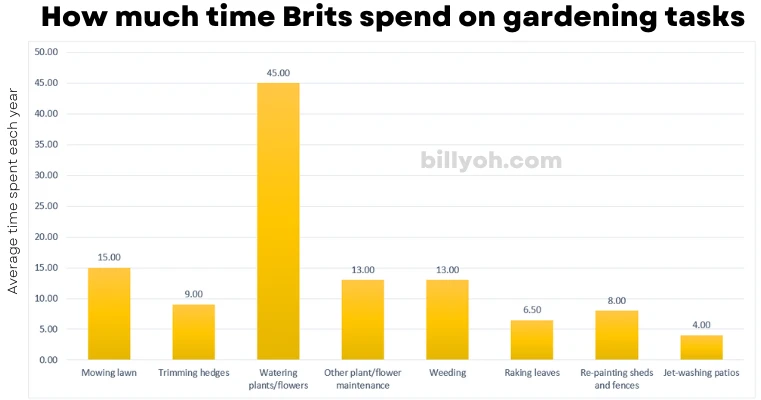
87. The number of Mars bars you can burn off in a year by doing some light gardening for one hour per week. (hta.org.uk)
What Gardeners are Growing
Outdoor plants. Most popular gardening products in the UK. (Statista.com)
68%. The percentage of British gardeners that consider the health & wellbeing properties of a plant before purchase. (Garden Trends Report 2018)
25%. Percent increase in the sales of grown-to-maturity plants over the last 3 years. (Garden Trends Report 2018)
14%. Percent increase in sales of pre-planted containers and baskets year-over-year. (Garden Trends Report 2018)
Fruit plants and trees have been losing popularity in the last five years to increased sales of vegetables (+30%) and herbs (+21%). (Garden Trends Report 2018)
Google searches for ‘air purifying plants’ and ‘aloe vera’ were up 550% year-over-year in 2017, with searches for air-cleaning ‘snake plants’ up 700%. (Garden Trends Report 2018)
Millennials are 88% more likely to keep plants in their bedrooms than those aged 65 and over. (Garden Trends Report 2018)
More than three quarters of gardeners try to avoid using chemicals in their gardens, with 46% of the using organic fertilizers instead. (Garden Trends Report 2018)
+36% — sales growth of outdoor plants in 2021. (gardenforum.co.uk)
+22% — sales growth of garden sundries in 2021. (gardenforum.co.uk)
38% of UK gardeners use their outdoor space to grow fruit, vegetables, or herbs. (Garden Industry Statistics)
49% of UK gardeners have roses in their gardens. (Garden Industry Statistics)
Where People Get Information About Gardening
67%. The number of Brits that get their gardening knowledge from the internet and social media. (Garden Trends Report 2018)
Indoor plants account for over 20 million searches on Instagram. (Airtasker.com)
90% increase in searches for “Indoor Plants” on Pinterest in 2017. (Airtasker.com)
50% increase in searches for “Cactus Plants” on Pinterest in 2017. (Airtasker.com)
Fishborne Cactus saw a 2,280% increase in Google searches. (Airtasker.com)
Bunny Ear Cactus saw a 1,985% increase in Google searches. (Airtasker.com)
60% increase in searches for “Hanging Plants” on Pinterest in 2017. (Airtasker.com)
70% increase in searches for “Terrariums” on Pinterest in 2017. (Airtasker.com)
47%. Number of people in the UK that believe social media will influence gardening trends in 2018. (Garden Trends Report 2018)
25% – get their garden inspiration from television programmes. (Garden Industry Statistics)
Where gardeners shop
B&Q is the preferred DIY and gardening brand of 54 percent of respondents in 2020. Wilko came in second place, with 48 percent of respondents. (Statista.com)
312. Number of B&Q stores in the UK and Ireland. (Statista.com)
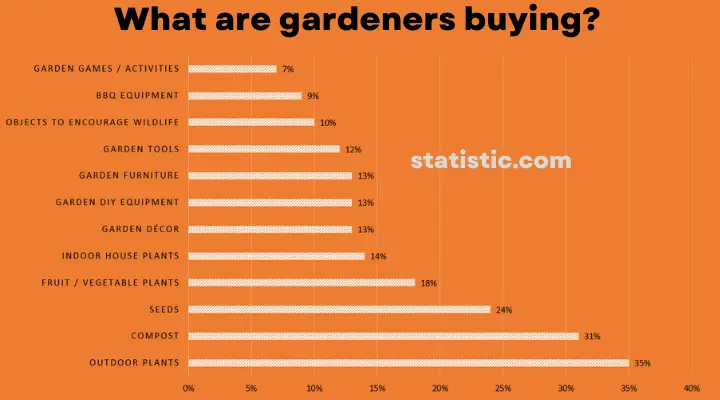
B&Q runs stores both in the UK and Ireland, and the sales value generated from these operations was 3.7 billion British pounds in the financial year 2020/21. (Statista.com)
The most popular gardening items bought online were plants, seeds, and bulbs, purchased by 80 percent of shoppers. The second most popular were lawn and plant care items, which 45 percent of shoppers preferred to buy online as opposed to 27 percent of consumers who went for in-store purchases in 2018. (Statista.com)
82k. Number of employees in specialized stores for the retail sale of flowers, plants etc. (Statista.com)
1.43bn GBP. Annual sales of Homebase in the UK. (Statista.com)
Over 6,500. The number of stores that specialize in the retail sales of plants, flowers, gardening equipment, and pet food in the UK in 2018. In 2009 there were nearly 1,000 less. (Statista.com)
1,800. The estimated number of garden centres and nurseries in the UK. (hta.org.uk)
What Brits spend on their gardens
£8.21bn GBP. Consumer spending on tools and equipment for house and garden. (Statista.com)
£678 GBP. Average spent annually on gardens. (Statista.com)
£28.2bn GBP. The estimated amount that ornamental horticulture and landscaping in the UK contributed to the national GDP in 2019. (hta.org.uk)
674,200. Number of jobs across the country supported by ornamental horticulture and landscaping. (hta.org.uk)
The average UK household spends around £150 on their garden each year. (hta.org.uk)
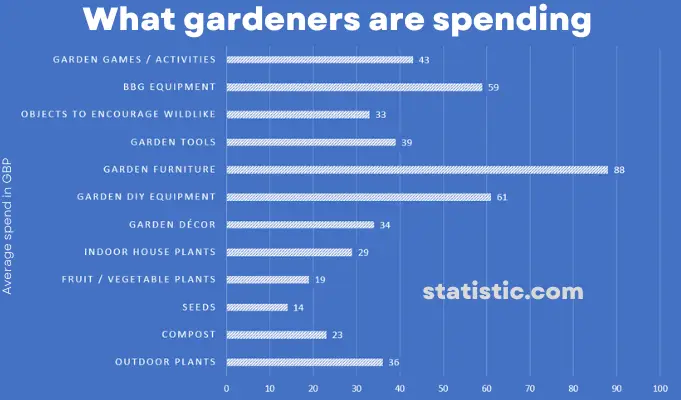
£4.00 GBP. Average weekly household expenditure on horticultural goods, garden equipment and plants by all households. (Statista.com)
£9.60 GBP. Average weekly household expenditure among highest ten percent gross income group on horticultural goods, garden equipment and plants. (Statista.com)
In 2021, UK households purchased approximately 7.6 billion GBP worth of plants and flowers and other garden goods, considerably more than just two years before. (Statista.com)
Britain’s per capita garden expenditure was just short of £680, with London’s gardening spend being one of the lowest. (Statista.com)
Respondents aged 50 to 64 spent an average of £4.70 a week on horticultural goods, garden equipment and plants. The age group that spent the most was the 65 to 74 group, spending on average £4.80 per week. (Statista.com)
In 2021, consumers in the UK spent just over eight billion British pounds on garden, plants, and flowers. (Statista.com)
£1.47 billion. GVA (Gross Value Added) of flowers, plants, seeds, fertilizers, pet animals and pet food retail sales. (Statista.com)
In 2020, the estimated total value sales of garden products in the United Kingdom were £4.92 billion. By 2025, the total value sales of garden products are forecasted to reach £6.66 billion. (Statista.com)
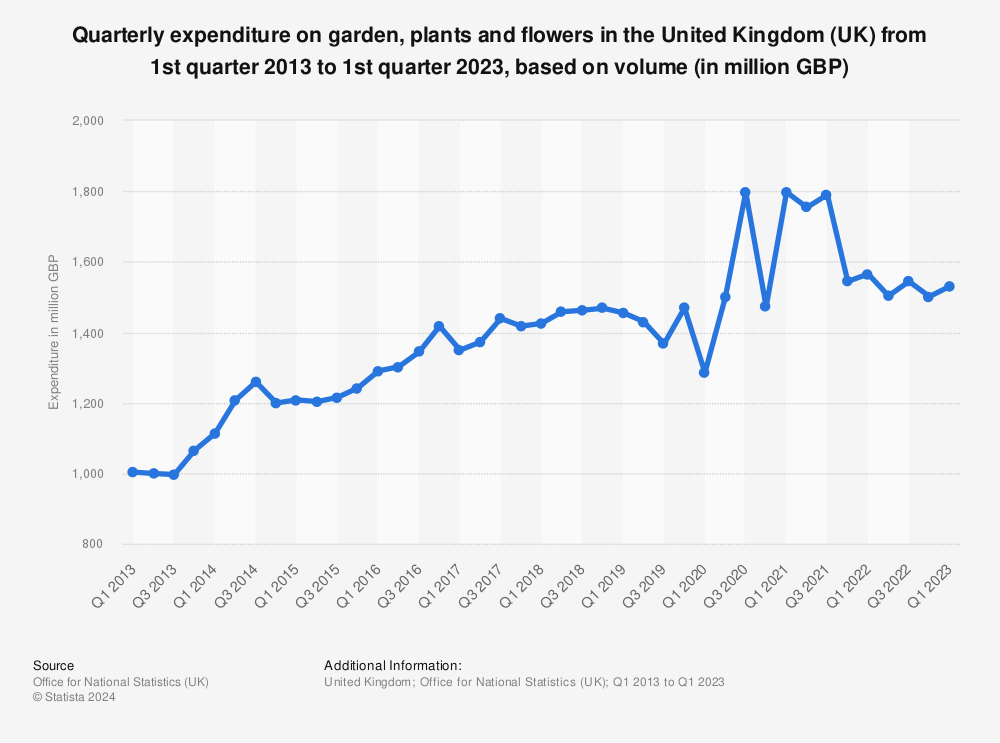
Quarterly expenditures on garden, plants, and flowers in the UK from 1st quarter 2013 to 4th quarter 2021, based on volume.
£4.29 billion. Total sales of garden products in the UK. (Statista.com)
£414.84. Typical amount that 18–24-year-olds spend on houseplants. (independent.co.uk)
£306.72. Typical amount that a Brit spends per year on houseplants. (independent.co.uk)
£5 billion. Annual garden retail market value. (Garden Trends Report 2018)
-12%. Percent average revenues are down for garden centres for the first 6 months of 2022. Garden sundries is the biggest faller (-19%) followed by Furniture and BBQ (-16%), Outdoor Plants (-13%) and gifts (-3%). (gardenforum.co.uk)
The average customer spend in garden centres was £35.62 in June 2022, an increase of +24% on 2019, when it was £28.69. With revenues up +12%, it suggests the number of customer transactions are below pre-pandemic levels. (gardenforum.co.uk)
The average spend in garden centre restaurants was £11.41 in June, 2022. This has fallen from £12.58 last June but is an increase of +31% on the average of £8.68 paid in 2019. This is likely to be the result of more garden restaurants using table service. (gardenforum.co.uk)
The total online market was down -16.7% in the first 6 months of 2022, with categories such as gardening and homeware plummeting over -30%. Cost of living concerns are changing consumer priorities. All categories are reporting negative growth aside from clothing. The total market is down -16.7% in H1, with categories such as gardening and homeware plummeting over -30%. (gardenforum.co.uk)
10%. Estimated inflation rate in garden products in 2022. (gardenforum.co.uk)
Furniture and BBQ was the fastest growing category, +58% in 2021. (gardenforum.co.uk)
£24 billion. The amount the horticulture industry is worth to the UK economy each year. (gardenforum.co.uk)
2,000. The estimated number of garden centres and retail nurseries in the UK. (Garden Industry Statistics)
£5 billion. The estimated value of the UK garden market, excluding landscaping and amenity sectors. (Garden Industry Statistics)
£1.4 Billion. What consumers in the UK spend on plants per year. (Garden Industry Statistics)
£24.2 billion. The estimated contribution to the British economy from the ornamental horticulture and landscaping industries. (Garden Industry Statistics)
£940 million. What we spend on garden and leisure annually. (Garden Industry Statistics)
Adults aged 45-54 spend more than any other group on gardening. (Garden Industry Statistics)
In 2021, consumer spending reached approximately 8.21 billion British pounds, representing an increase of 880 million on the previous year. (Statista.com)
£16 billion. Amount gardeners spent on their gardens in 2020. (Stihl.com)
Gardening Doesn’t Always Come Up Smelling like Roses
1 million. The number of garden crimes reported a year. (thecrimepreventionwebsite.com)
50%. The percentage jump in garden crime during the summer months. (thecrimepreventionwebsite.com)
£400 million. The cost to victims of garden crime. (thecrimepreventionwebsite.com)
1 in 7. The number of gardens that will experience a garden theft each year. (thecrimepreventionwebsite.com)
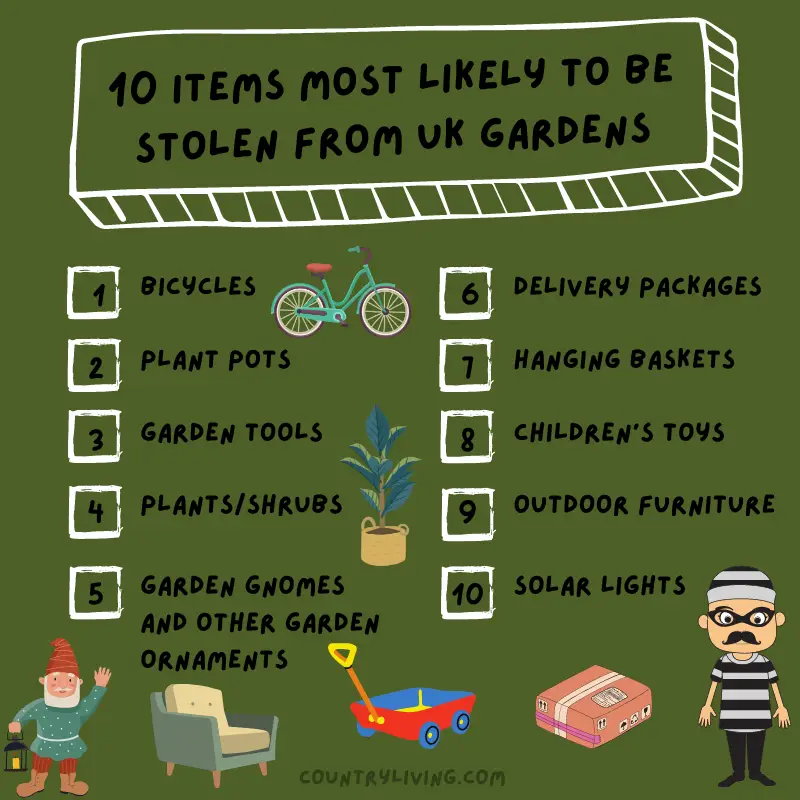
23%. Percentage that theft from UK gardens has risen since 2017, with an additional 112,000 offences. (Countryliving.com)
300,000. Approximate number of people hurt in their gardens each year seriously enough to go to the hospital (110,000 of them children). Around 87,000 are injured actively gardening or carrying out DIY jobs in the garden. (RoSPA)
The most common accident in a garden is a fall (115,000), but the biggest threat to people while gardening is a cut (19,000), then falls (18,000) and being struck by things (12,600). (RoSpa)
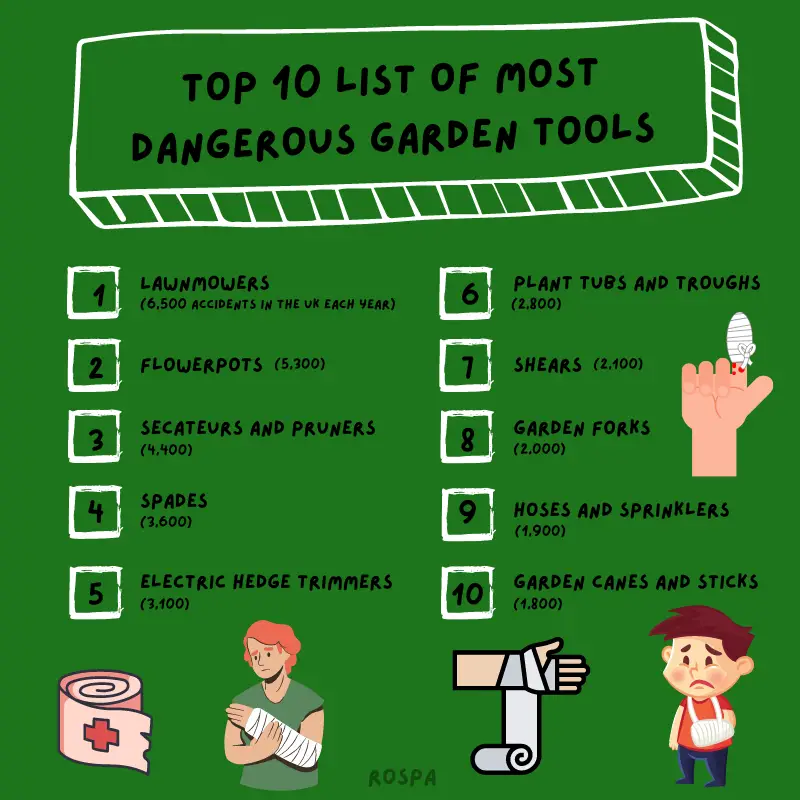
Almost 1 in 10 (9%) claim they find gardening stressful. (Lakeland-furniture.co.uk)
Those aged 16 to 24 are likeliest to find gardening stressful (14.45%) and as we get older, fewer of us are likely to be stressed by the task. Just 4.77% of over 55s claim to find it stressful. (Lakeland-furniture.co.uk)
Those in Yorkshire and the Humber are more than twice as likely to find gardening stressful as those in the South West and Wales. (Lakeland-furniture.co.uk)
There are only 3 regions where it’s regarded as stressful by more than 1 in 10. Yorkshire is one and is joined on the list by Greater London and the North East. (Lakeland-furniture.co.uk)
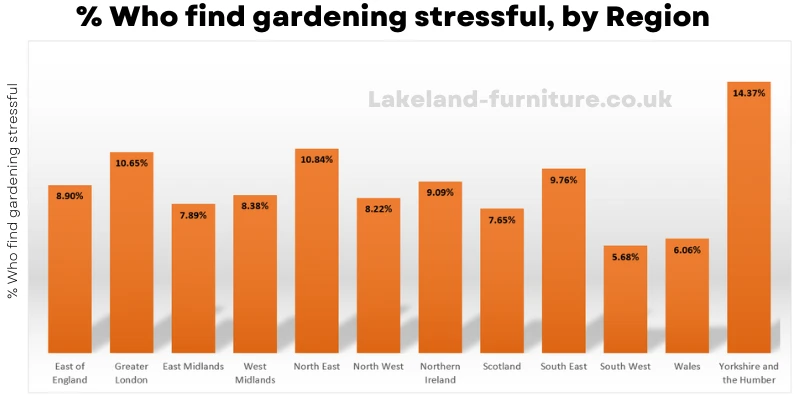
Gardening DIY (Not!)
In June 2021, searches in Google UK for “Gardeners near me” peaked at 41,850 per month. (According to ahrefs.com)
1 in 20 of survey respondents say they hire a gardener to deal with their gardening. (Lakeland-furniture.co.uk)
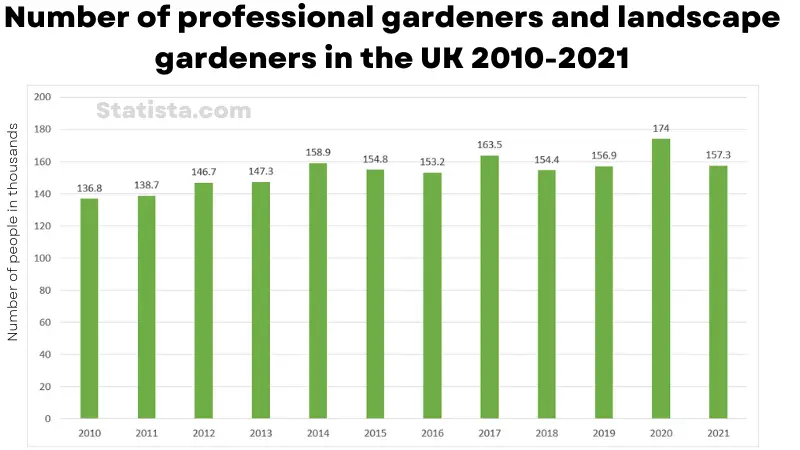
£2.4 billion. Average spent on the services of gardeners and landscapers annually. (Garden Industry Statistics)
£5 billion. Market size of landscaping services in the UK. (ibisworld.com)
19,583. Number of landscaping services businesses in the UK. (ibisworld.com)
570,000. The number of jobs in the UK created by the ornamental horticulture and landscaping industries. (Garden Industry Statistics)
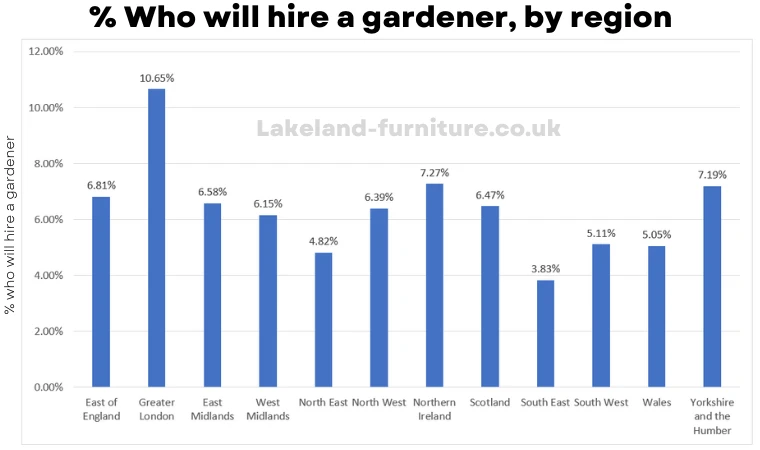
80,226. Landscaping services industry employment in the UK. (ibisworld.com)
In 2021, there were approximately 157.3 thousand people employed or self-employed as gardeners and landscape gardeners in the United Kingdom in 2021, compared with 136.8 thousand in 2010. (Statista.com)
You may also be interested in…
Blog Post Sharing Policy
You have our permission to share any of these statistics or charts as long as you include a dofollow link back to this page.

Darrell has a passion for gardening that he inherited from his father. Go here to read more about the influence his father played in his love for gardening. If you want to send Darrell a quick message, then visit his contact page here.

